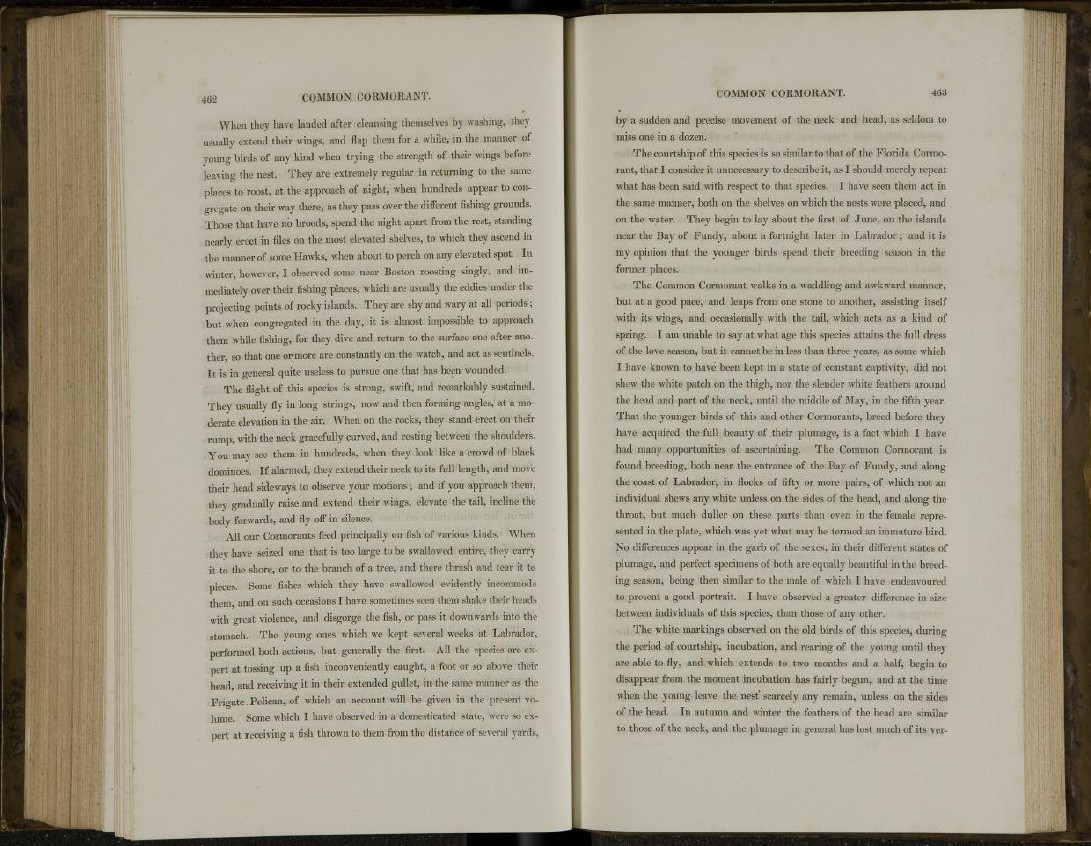
by a sudden and precise movement of the neck and head, as seldom to
miss one in a dozen.
The courtship of this species is so similar to that of the Florida Cormorant,
that I consider it unnecessary to describe it, as I should merely repeat
what has been said with respect to that species. I have seen them act in
the same manner, both on the shelves on which the nests were placed, and
on the water. They begin to lay about the first of June, on the islands
near the Bay of Fundy3 about a fortnight later in Labrador; and it is
my opinion that the younger birds spend their breeding season in the
former places.
The Common Cormorant walks in a waddling and awkward manner,
but at a good pace, and leaps from one stone to another, assisting itself
with its wings, and occasionally with the tail, which acts as a kind of
spring. I am unable to say at what age this species attains the full dress
of the love season, but it cannot be in less than three years, as some which
I have known to have been kept in a state of constant captivity, did not
shew the white patch on the thigh, nor the slender white feathers around
the head and part of the neck, until the middle of May, in the fifth year.
That the younger birds of this and other Cormorants, breed before they
have acquired the full beauty of their plumage, is a fact which I have
had many opportunities of ascertaining. The Common Cormorant is
found breeding, both near the entrance of the Bay of Fundy, and along
the coast of Labrador, in flocks of fifty or more pairs, of which not an
individual shews any white unless on the sides of the head, and along the
throat, but much duller on these parts than even in the female represented
in the plate, which was yet what may be termed an immature bird.
No differences appear in the garb of the sexes, in their different states of
plumage, and perfect specimens of both are equally beautiful in the breeding
season, being then similar to the male of which I have endeavoured
to present a good portrait. I have observed a greater difference in size
between individuals of this species, than those of any other.
The white markings observed on the old birds of this species, during
the period of courtship, incubation, and rearing of the young until they
are able to fly, and which extends to two months and a half, begin to
disappear from the moment incubation has fairly begun, and at the time
when the young leave the nest' scarcely any remain, unless on the sides
of the head. In autumn and winter the feathers of the head are similar
to those of the neck, and the plumage in general has lost much of its ver-
When they have landed after cleansing themselves by washing, they
usually extend their wings, and flap them for a while, in the manner of
young birds of any kind when trying the strength of their wings before
leaving the nest. They are extremely regular in returning to the same
places to roost, at the approach of night, when hundreds appear to congregate
on their way there, as they pass over the different fishing grounds.
Those that have no broods, spend the night apart from the rest, standing
nearly erect in files on the most elevated shelves, to which they ascend in
the manner of some Hawks, when about to perch on any elevated spot. In
winter, however, I observed some near Boston roosting singly, and immediately
over their fishing places, which are usually the eddies under the
projecting points of rocky islands. They are shy and wary at all periods;
but when congregated in the day, it is almost impossible to approach
them while fishing, for they dive and return to the surface one after another,
so that one ormore are constantly on the watch, and act as sentinels.
It is in general quite useless to pursue one that has been wounded.
The flight of this species is strong, swift, and remarkably sustained.
They usually fly in long strings, now and then forming angles, at a moderate
elevation in the air. When on the rocks, they stand erect on their
rump, with the neck gracefully curved, and resting between the shoulders.
You may see them in hundreds, when they look like a crowd of black
dominoes. If alarmed, they extend their neck to its full length, and move
their head sideways to observe your motions ; and if you approach them,
they gradually raise and extend their wings, elevate the tail, incline the
body forwards, and fly off in silence.
All our Cormorants feed principally on fish of various kinds. When
they have seized one that is too large to be swallowed entire, they carry
it to the shore, or to the branch of a tree, and there thrash and tear it to
pieces. Some fishes which they have swallowed evidently incommode
them, and on such occasions I have sometimes seen them shake their heads
with great violence, and disgorge the fish, or pass it downwards into the
stomach. The young ones which we kept several weeks at Labrador,
performed both actions, but generally the first. All the species are expert
at tossing up a fish inconveniently caught, a foot or so above their
head, and receiving it in their extended gullet, in the same maimer as the
Frigate Pelican, of which an account will be given in the present volume.
Some which I have observed in a domesticated state, were so expert
at receiving a fish thrown to them from the distance of several yards,